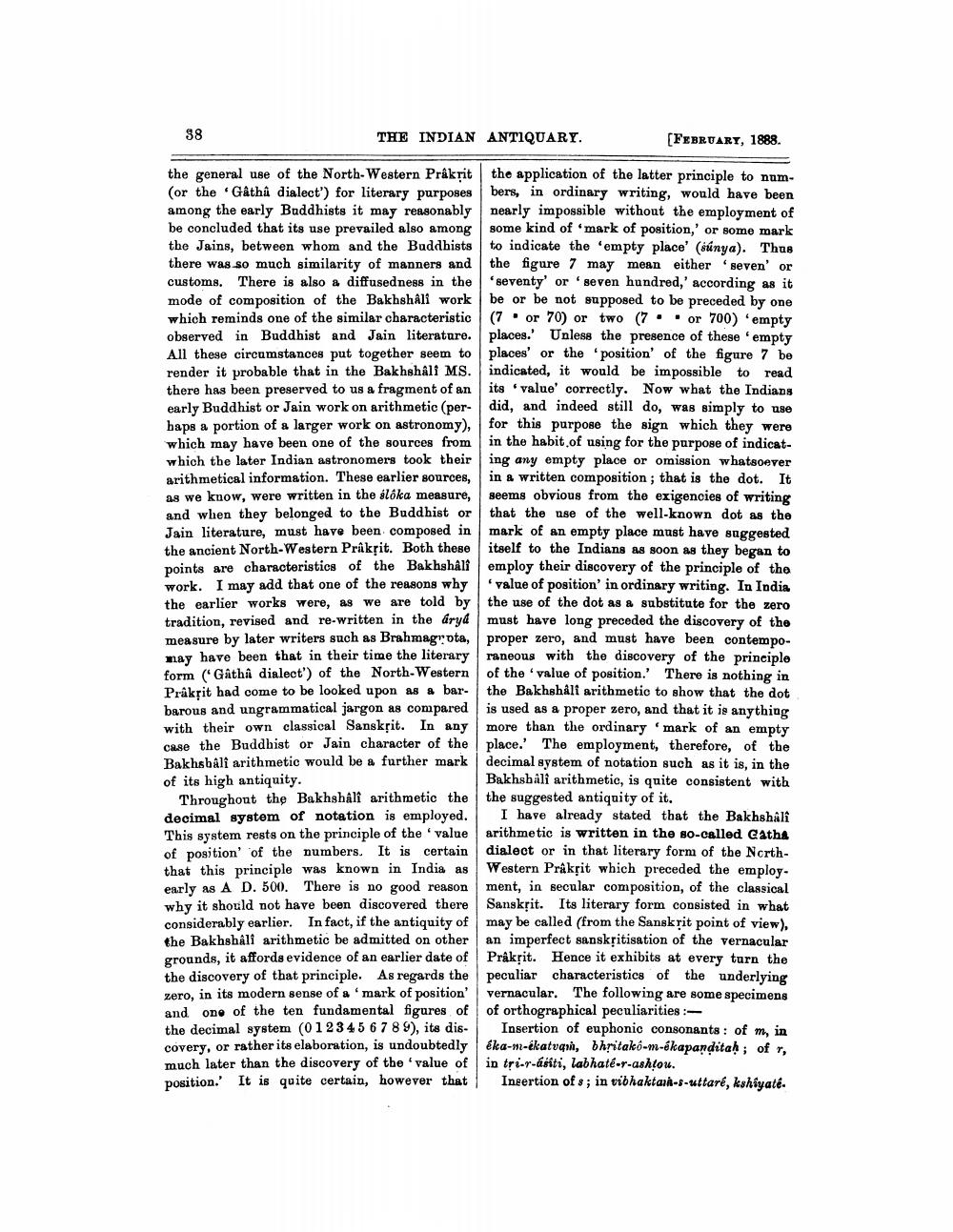________________
38
THE INDIAN ANTIQUARY.
(FEBRUARY, 1888.
the general use of the North-Western Präksit the application of the latter principle to num(or the Gathî dialect') for literary purposes bers, in ordinary writing, would have been among the early Buddhists it may reasonably nearly impossible without the employment of be concluded that its use prevailed also among some kind of mark of position,' or some mark the Jains, between whom and the Buddhists to indicate the "empty place' (stnya). Thus there was so much similarity of manners and the figure 7 may mean either seven' or customs. There is also a diffusedness in the seventy' or 'seven hundred,' according as it mode of composition of the BakhshAli work be or be not supposed to be preceded by one which reminds one of the similar characteristic (7 or 70) or two (7..or 700) empty observed in Buddhist and Jain literature. places. Unless the presence of these empty All these circumstances put together seem to places' or the position of the figure 7 be render it probable that in the Bakhshall MS. indicated, it would be impossible to read there has been preserved to us a fragment of an its value' correctly. Now what the Indians early Buddhist or Jain work on arithmetic (per- did, and indeed still do, was simply to use haps a portion of a larger work on astronomy), for this purpose the sign which they were which may have been one of the sources from in the habit of using for the purpose of indicatwhich the later Indian astronomers took their ing any empty place or omission whatsoever arithmetical information. These earlier sources, in & written composition; that is the dot. It as we know, were written in the slóka measure, seems obvious from the exigencies of writing and when they belonged to the Buddhist or that the use of the well-known dot as the Jain literature, must have been composed in mark of an empty place must have suggested the ancient North-Western Prakrit. Both these itself to the Indians as soon as they began to points are characteristics of the Bakhshali employ their discovery of the principle of the work. I may add that one of the reasons why value of position' in ordinary writing. In India the earlier works were, as we are told by the use of the dot as a substitute for the zero tradition, revised and re-written in the arya must have long preceded the discovery of the measure by later writers such as Brahmagyuta, proper zero, and must have been contempomay have been that in their time the literary raneous with the discovery of the principle form (Gåthå dialect) of the North-Western of the value of position. There is nothing in Prakrit had come to be looked upon as a bar. the Bakhshali arithmetic to show that the dot barous and ungrammatical jargon as compared is used as a proper zero, and that it is anything with their own classical Sanskrit. In any more than the ordinary mark of an empty case the Buddhist or Jain character of the place. The employment, therefore, of the Bakhsbáli arithmetic would be a further mark decimal system of notation such as it is, in the of its high antiquity.
Bakhsbali arithmetic, is quite consistent with Throughout the Bakhshali arithmetic the the suggested antiquity of it. decimal system of notation is employed. I have already stated that the Bakhshali This system rests on the principle of the value arithmetic is written in the so-called catha of position of the numbers. It is certain dialect or in that literary form of the Norththat this principle was known in India as Western Prakrit which preceded the employ. early as A D. 500. There is no good reason ment, in secular composition, of the classical why it should not have been discovered there Sanskrit. Its literary form consisted in what considerably earlier. In fact, if the antiquity of may be called (from the Sanskrit point of view), the Bakhshali arithmetic be admitted on other an imperfect sansksitisation of the vernacular grounds, it affords evidence of an earlier date of Prakrit. Hence it exhibits at every turn the the discovery of that principle. As regards the peculiar characteristics of the underlying zero, in its modern sense of a 'mark of position' vernacular. The following are some specimens and one of the ten fundamental figures of of orthographical peculiarities :the decimal system (0 1 2 3 4 5 6 7 8 9), its dis- Insertion of euphonic consonants : of m, in covery, or rather its elaboration, is undoubtedly éka-1-ékatvara, bhritakó-m-ékapanditah; of , much later than the discovery of the value of in tri-r-asiti, labhaté-r-ashtou. position. It is quite certain, however that Ineertion of s; in vibhaktara-s-uttaré, kshiyaté.




